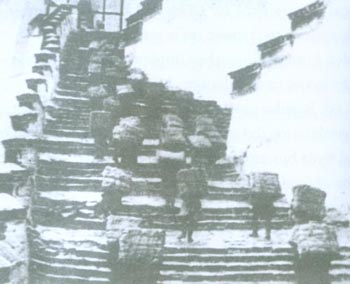Conclusions drawn from the establishment of Khral-Ula corvee system and the history of the reforms and consolidations are as follows:
(1)The Central Government had always attached great importance to Khral-Ula in taxation police, which not only concerned the financial subsidy from the Central Government, the benefits to monasteries and aristocrats and the burdens of farmers and herdsmen, but also exerted great influence on the stability of Tibet and the policies of the Qing government to bring peace to the country. Therefore, a great many reflections and requests on Khral-Ula were reported in the memorials by Ambans. In addition to regular checks and supervision, Ambans often put forward suggestions on regulations and sent messages to inform the local government of Tibet and bKra-shis-lhun-po Monastery to correct their errors and enforce new rules. Furthermore, they implemented a centralized reform and consolidation.
(2)Regular supervision and large-scale reform and consolidation did not touch internal Khral for manorial lords but emphasis was often put on the correction of feudal lords' taxes practices or their profits in the name of tax and corvee service.
(3)There were 3 kinds of tax categories for manors to burden taxpayers.
1.Agricultural tax, including land tax payable from the actual cultivators, Ula (including people, horse and packed animals) or cash tokens assigned by the special Khral. These were the only aspect that the special Khral. These were the only aspect that eh Central Government was to reform and consolidate.
2.Poll tax. Craftsmen and vagabonds without land and living in manors were required to pay personal tax to the lords, which was internal Khral characteristic of physical subordination. The poll tax occasionally imposed by the government in certain areas was external Khral, and these two kinds of tax collection should not be mixed.
3.Handicraft products tax. To meet the demands of the government instead of from land, this tax came from local produce and handicraft products such as medicinal materials, fruits, dyes, paper, tweed, jade bowls, ceramics and brooms. In a word, whatever was produced would be collected.

"Trapa" (khral-pa) serfs carrying goods to the Potala
4.The net revenue from the government's self managed land did not belong to Khral Ula. The products were handed in to the government according to a ration. However, Ambans always interfered in the management of the government according to a ration. However, Ambans always interfered in the management of the government's manors. For instance, in 1975 (the sixtieth year of Emperor Qianlong's reign), Song Yun, the Gradn Minister Residents of Tibet, is sued "An Official Notice to Avoid Deception in Rendering Rationed Ula Service (internal service) for the Government". Claiming: the agents of the manors were in charge of country estates attached to the government, however, some of them would collect 4-5 Khrals of grain per Khral of seed." "Land in this kind of country estate was tilled and irrigated by corvee laborers (usually external Khral laborers) called upon by the agents of the manors in the vicinity. Except for the prescribed products handed in to the government after the harvest, the rest were at the agents' disposal and the corvee laborers got nothing." The notice listed five kinds of miseries of Ula corvee, saying: from the next year "if a Ula corvee laborer was sent every year in each manor, his owner would be relieved from hading in the grain of 2 Khals and 10 sheng (instrument for measuring grain), (and those non-government Khral laborers who tilled the land for the government manors were bestowed with two Khals and 10 sheng of highland barley-noted by the translator) so as to relax the financial resources of the laborers." In response to these demands, the government's manors were asked to hand in two copies of documents concerning the weight of seed, the land area per year, and the number of corvee laborers used for each Khal of seed in land. One copy was to present to the imperial envoy and the other to the government, and anyone who was found unable to carry out the policy would be "seriously punished". A definite tax rate for the government's Khral-pa's parceled hand and earmarked Kharlrten was worked out. The Khral that Khral-pa turned in from his parceled land was called "Sa-khral", which meant land rent in Chinese, but it still belonged to the genre of "Kral".
III. The Basic Characteristics of Khral-Ula System
1.The Bestowal Policy under the State Ownership of Land-the Basis of the Existence of the Khral-Ula System
In Tibetan feudal serfdom serfdom society, land was state owned which the Emperor and his agents in Tibet could either handsomely bestow or take back. The granted land could only be utilized and could only be utilized and cold not be bought or sold without permission. In the Qing Dynasty, the Fifth Dalai Lama took advantage of the power bestowed upon him by the Emperor to confiscate land from his enemies and granted them to the monasteries of the Yellow Sect and the aristocrats. In the wake of the formulation of The Twenty-Nine-Article Imperially Approved Ordinance for the More Efficient Governing of Tibet in 1793, the rights of land recall and land bestowal upon meritorious clerical and lay officials were centralized on Ambans, and big issues needed the Emperor's approval. The system of land bestowal upon clerical and lay officials who were offered high positions was not only the product of socio-historical development, and also the economic basis for the existence and stability of Tibetan religious denominations. The constant bestowal upon aristocrats and monasteries and their successive occupation of land by force formed aristocratic and monastic manors of different sizes. In the Qing Dynasty, the reform and consolidation of the Khral-Ula system was carried out based on the government's restrictions which included.
